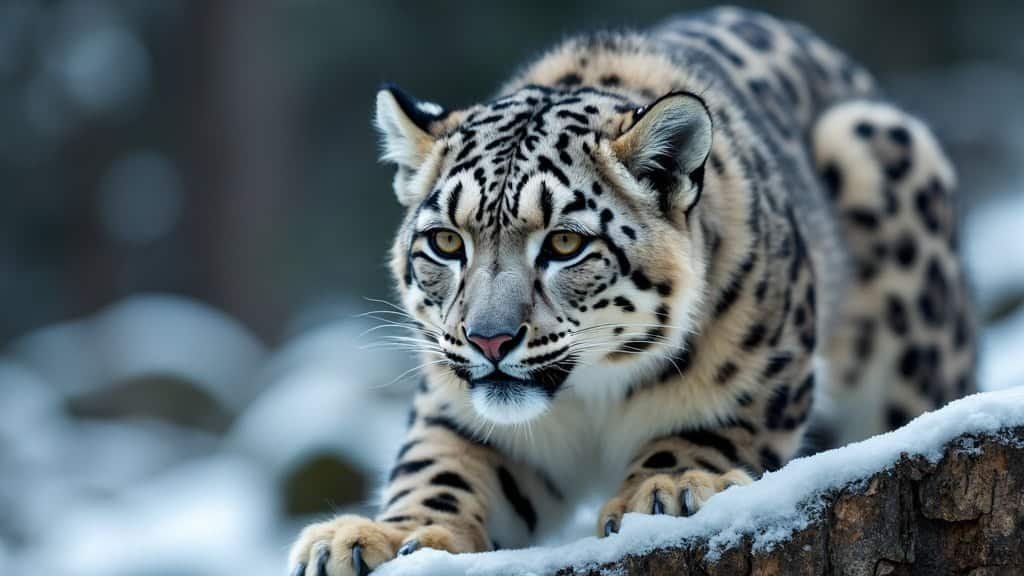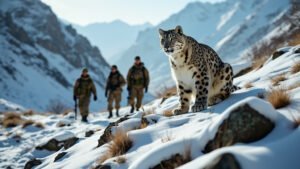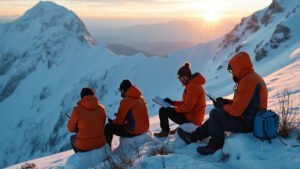Introduction
Snow leopards, elusive and majestic, are facing numerous threats that endanger their survival. Conservation strategies are crucial to protect these magnificent big cats and ensure their future
This article explores various approaches to snow leopard conservation, from habitat preservation and addressing threats to community engagement and international cooperation. We also delve into the technological advancements aiding these efforts
By understanding and implementing these strategies, we can contribute to the protection and conservation of snow leopards in their natural habitats
Habitat Preservation and Restoration
Snow leopards inhabit some of the most remote and rugged terrains in the world. These high-altitude areas are not only harsh but also crucial for the survival of this elusive species
Habitat preservation and restoration play a pivotal role in snow leopard conservation, as these regions provide the necessary environment for their existence and reproduction
Importance of Snow Leopard Habitats
Snow leopards are found in 12 countries across Central and South Asia, with the largest populations in China, Mongolia, and India
Their habitats range from 9,800 to 14,800 feet above sea level, covering various mountain ranges including the Himalayas, Altai, and Tien Shan. These habitats are characterized by rocky outcrops, steep cliffs, and sparse vegetation, which offer the perfect camouflage for these solitary predators
Habitat preservation is essential because it ensures that snow leopards have access to their natural prey, such as blue sheep, ibex, and marmots. Healthy ecosystems also support a wide range of biodiversity, which is vital for maintaining the ecological balance
According to the Snow Leopard Trust, preserving these habitats helps maintain the integrity of the larger ecosystem, benefiting not only snow leopards but also other species that share their range (Snow Leopard Trust, 2022)
Strategies for Habitat Protection
Several strategies are employed to protect and preserve snow leopard habitats:
Protected Areas: Establishing and managing protected areas, such as national parks and wildlife reserves, is a fundamental approach. These areas provide safe havens where snow leopards can thrive without the threat of human encroachment. For instance, the Hemis National Park in India is one of the largest protected areas for snow leopards, covering over 1,700 square miles
Habitat Corridors: Creating habitat corridors that connect fragmented landscapes allows snow leopards to roam freely and access different parts of their range. This connectivity is crucial for genetic diversity and reduces the risk of inbreeding. The Global Snow Leopard and Ecosystem Protection Program (GSLEP) has been instrumental in promoting the establishment of these corridors across several countries
Sustainable Land Use Practices: Promoting sustainable land use practices among local communities helps reduce habitat degradation. This includes encouraging herders to adopt grazing practices that do not overexploit pasturelands, thereby maintaining the quality of the habitat
Success Stories in Habitat Restoration
Successful habitat restoration projects have demonstrated the positive impact of targeted conservation efforts. One notable example is the Tost Mountains in Mongolia
Initially threatened by mining activities, this critical snow leopard habitat was declared a Local Protected Area in 2016, spanning over 6,400 square miles. Since then, the snow leopard population in this region has shown signs of recovery, highlighting the effectiveness of legal protection and habitat restoration efforts
Another success story comes from the Wakhan Corridor in Afghanistan. Despite the challenging political and security situation, conservationists have collaborated with local communities to protect snow leopard habitats
Through community-based conservation programs, such as the establishment of grazing-free zones, the habitat quality has improved, providing a safer environment for snow leopards and their prey
Addressing Threats to Snow Leopards
Snow leopards face a multitude of threats that jeopardize their survival in the wild. These threats range from poaching and illegal trade to human-wildlife conflict and the impacts of climate change. Addressing these threats is critical to ensuring the long-term conservation of snow leopards
Poaching and Illegal Trade
One of the most significant threats to snow leopards is poaching. Snow leopards are hunted for their beautiful fur, bones, and other body parts, which are sold in illegal wildlife markets
According to TRAFFIC, a wildlife trade monitoring network, poaching for the illegal wildlife trade is a major driver of snow leopard population declines (TRAFFIC, 2020)
Efforts to combat poaching involve a combination of law enforcement, community engagement, and international cooperation. Enhanced law enforcement in protected areas and along borders helps to deter poachers and intercept illegal wildlife products
Training and equipping rangers with the necessary tools and skills to effectively patrol snow leopard habitats is a critical component of this strategy
Community engagement programs are also essential in reducing poaching. By involving local communities in conservation efforts and providing alternative livelihoods, the incentive for poaching can be diminished
For example, the Snow Leopard Trust’s handicraft program allows local women to earn a sustainable income by producing and selling traditional handicrafts, reducing their dependence on poaching (Snow Leopard Trust, 2021)
Human-Wildlife Conflict
Human-wildlife conflict is another major threat to snow leopards. As human populations expand and encroach on snow leopard habitats, interactions between snow leopards and livestock become more frequent. Snow leopards may prey on livestock, leading to retaliatory killings by herders
To mitigate human-wildlife conflict, several strategies are employed:
Livestock Insurance Programs: These programs compensate herders for livestock losses due to snow leopard predation. By reducing the financial burden on herders, these programs help to prevent retaliatory killings. The Snow Leopard Enterprises program, implemented by the Snow Leopard Trust, has been successful in reducing human-wildlife conflict by providing insurance schemes for local herders
Predator-Proof Corrals: Constructing predator-proof corrals to protect livestock at night reduces the risk of snow leopard attacks. These corrals are designed to be robust and secure, preventing snow leopards from accessing livestock
Community-Based Conservation: Engaging local communities in conservation efforts helps to foster a sense of stewardship and reduces conflicts. Programs that involve local people in monitoring snow leopard populations and habitats create a collaborative approach to conservation. In the Spiti Valley of India, community-based initiatives have led to a significant reduction in human-wildlife conflict (WWF India, 2019)
Climate Change Impact
Climate change poses a long-term threat to snow leopards and their habitats. Rising temperatures and changing precipitation patterns can alter the alpine ecosystems that snow leopards depend on. For example, the upward shift of tree lines due to warming temperatures can reduce the availability of suitable habitats for snow leopards
Addressing the impacts of climate change involves:
Climate-Resilient Habitat Management: Ensuring that snow leopard habitats are managed to withstand the impacts of climate change is crucial. This includes protecting key habitat areas that are predicted to remain suitable under future climate scenarios and restoring degraded habitats to enhance their resilience
Research and Monitoring: Ongoing research and monitoring are essential to understanding the impacts of climate change on snow leopards and their prey. By collecting data on snow leopard populations, prey availability, and habitat conditions, conservationists can develop adaptive management strategies to mitigate the effects of climate change
Advocacy and Policy: Advocating for policies that address climate change at local, national, and international levels is vital. Conservation organizations work to raise awareness about the impacts of climate change on snow leopards and advocate for actions to reduce greenhouse gas emissions and promote sustainable land use practices
Community Engagement and Education
Effective conservation of snow leopards involves not only scientific and technological approaches but also the active participation of local communities. Community engagement and education are critical components of conservation strategies, fostering a sense of stewardship and ensuring the sustainability of conservation efforts.
Role of Local Communities
Local communities living in snow leopard habitats are key stakeholders in conservation efforts
Their daily activities and livelihoods are closely intertwined with the environment, and their cooperation is vital for the success of conservation programs. By involving local people in conservation initiatives, we can create a collaborative approach that benefits both snow leopards and human communities
One effective strategy is the establishment of community-managed conservation areas. These areas are managed by local communities with support from conservation organizations, allowing residents to take ownership of the conservation process
In the Annapurna region of Nepal, for example, community-managed conservation areas have successfully protected snow leopard habitats while promoting sustainable livelihoods for local people (Annapurna Conservation Area Project, 2021)
Educational Programs and Initiatives
Education is a powerful tool for promoting snow leopard conservation. By raising awareness about the importance of snow leopards and the challenges they face, educational programs can inspire local communities and the broader public to take action:
School Programs: Introducing conservation education in schools helps to instill a sense of environmental responsibility in young people
Programs that include interactive lessons, field trips, and involvement in local conservation projects can be particularly effective. The Snow Leopard Trust’s environmental education program in Mongolia has reached thousands of students, teaching them about snow leopards and the importance of protecting their habitats
Community Workshops: Workshops and training sessions for adults provide valuable knowledge and skills related to conservation practices
These workshops can cover topics such as sustainable herding practices, wildlife monitoring techniques, and conflict resolution strategies. In Kyrgyzstan, community workshops have been instrumental in training local herders to use predator-proof corrals and participate in wildlife monitoring efforts
Public Awareness Campaigns: Broad public awareness campaigns help to garner support for snow leopard conservation at local, national, and international levels
These campaigns can use various media, including social media, television, and radio, to reach a wide audience. The “Save Our Snow Leopards” campaign in India has successfully raised awareness and generated support for conservation initiatives through engaging videos, articles, and public events
Case Studies of Community Involvement
Successful conservation projects often highlight the importance of community involvement. Here are a few notable examples:
Pakistan’s Baltistan Wildlife Conservation and Development Organization (BWCDO): This community-based organization has worked with local communities in northern Pakistan to protect snow leopards and their habitats. Through initiatives such as livestock insurance programs, predator-proof corrals, and ecotourism, BWCDO has reduced human-wildlife conflict and improved the livelihoods of local people (BWCDO, 2020)
Tajikistan’s Conservancies: In Tajikistan, conservancies managed by local communities have proven effective in snow leopard conservation. These conservancies integrate traditional land-use practices with modern conservation strategies, fostering a balanced coexistence between people and wildlife. Community rangers conduct regular patrols to monitor snow leopards and prevent poaching, while sustainable tourism provides an alternative source of income for local residents (Panthera, 2021)
India’s Hemis National Park: In the Hemis National Park region, community engagement has been central to conservation efforts. Local communities participate in wildlife monitoring, habitat restoration, and educational programs. The Snow Leopard Conservancy India Trust has worked closely with these communities, providing training and resources to support their conservation efforts. This collaborative approach has led to a significant increase in snow leopard sightings and a reduction in human-wildlife conflict (Snow Leopard Conservancy India Trust, 2019)
International Cooperation and Policy
Conservation efforts for snow leopards require coordinated action across borders, involving multiple countries and international organizations. International cooperation and policy play a crucial role in addressing the challenges faced by snow leopards and ensuring their long-term survival
Global Conservation Agreements
International agreements and treaties provide a framework for countries to collaborate on snow leopard conservation. One of the most significant initiatives is the Global Snow Leopard and Ecosystem Protection Program (GSLEP), launched in 2013
GSLEP unites the 12 snow leopard range countries—Afghanistan, Bhutan, China, India, Kazakhstan, Kyrgyzstan, Mongolia, Nepal, Pakistan, Russia, Tajikistan, and Uzbekistan—in a collective effort to protect snow leopards and their habitats
The GSLEP aims to secure 20 snow leopard landscapes by 2020 and has made substantial progress toward this goal. It focuses on habitat protection, community engagement, and strengthening policies and institutions. The program also emphasizes transboundary cooperation, recognizing that snow leopard habitats often span multiple countries and require joint management efforts (GSLEP, 2020)
Role of NGOs and Governments
Non-governmental organizations (NGOs) and governments play a critical role in implementing and supporting snow leopard conservation policies. NGOs such as the Snow Leopard Trust, Panthera, and WWF work alongside governments to carry out conservation programs, conduct research, and advocate for stronger protections
Governments contribute by enacting and enforcing laws that protect snow leopards and their habitats. For instance, in China, the government has designated several snow leopard reserves and implemented anti-poaching measures
In India, the Ministry of Environment, Forest and Climate Change has developed a comprehensive snow leopard conservation plan that includes habitat restoration, conflict mitigation, and community involvement
Successes in International Collaboration
Successful international collaboration has led to several notable achievements in snow leopard conservation:
Transboundary Protected Areas: Establishing transboundary protected areas helps to safeguard continuous habitats that cross national borders
The Altai-Sayan Ecoregion, which spans Russia, Mongolia, Kazakhstan, and China, is a prime example. Collaborative efforts in this region have resulted in the creation of protected areas and improved habitat connectivity, benefiting snow leopards and other wildlife (WWF, 2021)
Joint Research and Monitoring: International research collaborations enhance our understanding of snow leopard populations and ecology
Projects such as the Global Snow Leopard & Ecosystem Protection Program’s Population Assessment of the World’s Snow Leopards (PAWS) involve scientists from multiple countries working together to gather and analyze data on snow leopard populations. This collaborative approach ensures more accurate and comprehensive data, guiding effective conservation strategies (GSLEP, 2020)
Funding and Resource Sharing: International funding and resource sharing are essential for supporting conservation projects. Organizations such as the Global Environment Facility (GEF) provide financial assistance for snow leopard conservation initiatives
Additionally, technical support and capacity building from international partners enhance the effectiveness of local conservation efforts. For example, the Snow Leopard Trust’s partnership with the German development agency GIZ has provided valuable resources for community-based conservation projects in Kyrgyzstan (Snow Leopard Trust, 2021)
Technological Advancements in Conservation
Modern technology plays a crucial role in enhancing snow leopard conservation efforts. From tracking movements to analyzing data, technological advancements provide valuable insights and tools that aid in the protection of these elusive big cats
Use of Camera Traps and GPS Collars
Camera traps and GPS collars are among the most effective technologies used in snow leopard research and conservation:
Camera Traps: These devices are strategically placed in snow leopard habitats to capture images and videos of the animals as they move through their environment
Camera traps provide critical data on snow leopard presence, behavior, and population density without disturbing the animals. According to a study by the Snow Leopard Trust, camera traps have significantly improved the accuracy of population estimates, revealing that there are likely between 4,500 and 7,500 snow leopards in the wild (Snow Leopard Trust, 2017)
GPS Collars: GPS collars are fitted onto snow leopards to track their movements and study their range, habitat use, and behavior. These collars transmit location data via satellite, allowing researchers to monitor snow leopards in real-time
The information gathered helps identify critical habitats, migration patterns, and potential human-wildlife conflict zones. For example, a study conducted in Mongolia used GPS collars to reveal that snow leopards have larger home ranges than previously thought, underscoring the need for expansive conservation areas (McCarthy et al., 2021)
Data Collection and Analysis
Data collection and analysis are fundamental to understanding snow leopard ecology and informing conservation strategies:
Genetic Analysis: Collecting and analyzing genetic material, such as scat samples, allows researchers to assess the genetic diversity and health of snow leopard populations. Genetic studies can identify related individuals, track lineage, and detect inbreeding
This information is vital for maintaining genetic diversity and ensuring the long-term survival of snow leopards. A genetic study published in the journal “Molecular Ecology” highlighted the importance of genetic diversity for the adaptability and resilience of snow leopard populations (Janečka et al., 2018)
Ecological Modeling: Advanced software and modeling techniques help predict how snow leopard populations might respond to various environmental changes, such as habitat loss and climate change
Ecological models integrate data on habitat preferences, prey availability, and climate variables to forecast future scenarios and guide conservation planning. A study in the “Journal of Applied Ecology” used ecological modeling to identify potential impacts of climate change on snow leopard habitats, recommending adaptive management strategies to mitigate these effects (Li et al., 2020)
Innovations in Wildlife Protection
Technological innovations are also improving wildlife protection efforts:
Drones: Unmanned aerial vehicles (drones) are increasingly used for monitoring snow leopard habitats. Drones can cover large and inaccessible areas, providing high-resolution imagery for habitat mapping and surveillance
They help detect illegal activities such as poaching and habitat destruction, allowing for rapid response by conservation authorities. A pilot project in India demonstrated the effectiveness of drones in patrolling snow leopard territories and reducing human disturbance (WWF India, 2021)
Smart Collars: Advanced GPS collars with built-in sensors and communication capabilities are being developed to enhance wildlife tracking
These smart collars can transmit real-time data on location, activity, and physiological parameters, offering deeper insights into snow leopard behavior and health. They also enable geo-fencing, alerting conservationists if a collared snow leopard enters a risky area, such as near human settlements
Artificial Intelligence (AI): AI technologies are revolutionizing data analysis and pattern recognition in wildlife conservation. Machine learning algorithms can process vast amounts of camera trap data, automatically identifying snow leopards and other species, and analyzing their behaviors
AI also aids in predicting poaching hotspots by analyzing historical data and identifying patterns. The use of AI in the Snow Leopard Trust’s monitoring programs has significantly enhanced the efficiency and accuracy of data analysis (Snow Leopard Trust, 2022)
Conclusion
Snow leopard conservation is a multifaceted endeavor that requires a combination of habitat preservation, threat mitigation, community engagement, international cooperation, and technological advancements
By protecting and restoring their habitats, addressing poaching and human-wildlife conflicts, and involving local communities in conservation efforts, we can create a sustainable environment where snow leopards can thrive
International collaboration and innovative technologies further enhance our ability to monitor and protect these magnificent creatures. Through continued and coordinated efforts, we can ensure a brighter future for snow leopards and the ecosystems they inhabit











